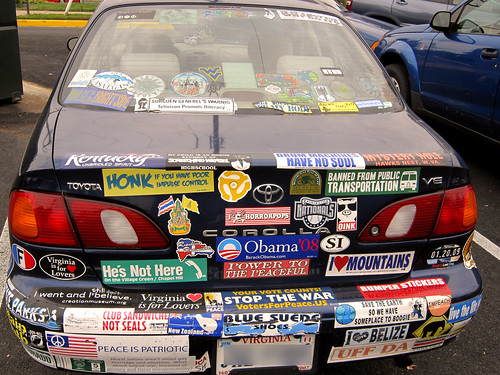Bumper Sticker Solutions
- Nedra Weinreich
- Mar 7, 2008
- 4 min read
I drove behind a car yesterday that made me wish I had my camera with me. It was a city parking enforcement vehicle, sporting bumper stickers like those I've often seen on other municipal vehicles such as police cars and utility trucks. But this one took it to another level. Plastered across its bumper were stickers that said:
DARE to Keep Kids Off Drugs
There's No Excuse for Domestic Violence
Don't Drink and Drive (or something to that effect)
and the kicker, delivered entirely straight-faced:
Keep Your Eyes on the Road.
This got me thinking about bumper stickers, as well as the context in which our messages may be seen. Bumper stickers are about as low-tech as you can get, but they're not going away. I'm always amazed that people are willing to put a semi-permanent adhesive slogan on their otherwise unblemished car, especially when it's for a political campaign that's of a limited duration. That takes commitment.
And that commitment is there because the bumper stickers people choose to put on their cars are firmly tied up with issues related to their identity. Cars are often an extension of our personality, and a bumper sticker extends that even farther beyond the automotive brand to get at our core values. That's why so many bumper stickers are political or cause-related. They can reflect the personality and values of the car's owner, whether idealistic ("Visualize World Peace"), witty ("Visualize Whirled Peas") or obnoxious ("F-- World Peace, Visualize Using Your Turn Signals"). Bumper stickers can also become a shorthand marker for being part of a "tribe" -- such as the rainbow symbol, the ichthys "Jesus fish," or the Darwin fish.
From "Save the Whales" to "Love Animals, Don't Eat Them" up to the current "Coexist" (with the letters made from symbols of different religions), bumper stickers have been used as part of cause-related communication and marketing campaigns over many years. Some merely promote the name and tagline of a nonprofit organization, while others try to change attitudes and behaviors.
Here are a few tips for using bumper stickers for your issue:
Make your words count. Like a billboard, you only have a small number of words to get your point across. Unlike a billboard, you don't have space for graphics and need to rely on the words to convey the idea without visuals. Make sure your message is clear and succinct, and make it memorable. The best bumper stickers make you laugh and then think.
Make it visible. The worst bumper stickers make you squint and mutter, "What does that say?" as you drive by. Use high-contrast dark lettering on light colors or light lettering on a dark background. Don't try to fit so many words on the sticker that you have to use a small font.
Make it ubiquitous. Figure out ways to encourage your supporters to put the bumper stickers on their cars. Give them away, provide incentives, pay college students to stick them around, use window clings if a sticker is too permanent for them... The more people see your bumper sticker, the more it will provide confirmation that support for your cause is socially acceptable and desirable.
Make it a social object. Bumper stickers can be conversation starters or a way for people to identify common interests. In junior high, a KLOS bumper sticker on our Pee-Chee folders was a coveted status symbol designating that we were cool enough to listen to that radio station.
Make it build curiosity. Drive around the US enough, and you will eventually see a car sporting a bumper sticker that says, "Where the heck is Wall Drug?" If you don't know the answer, the more you see cars with that sticker, the more it will continue to irritate those three neurons in the back of your brain devoted to the idea of Wall Drug. If you ever have the opportunity to find out the answer, you will do so just to satisfy that nagging curiosity. (Here in California, I often see bumper stickers that say, "I saw the Mystery Spot." Similar idea.) Ask a question. Make people wonder about the answer.
Make it special. If your bumper sticker is one of 20 (or even four) covering the back of someone's car, the message will be diluted (see the photo above). For more impact, your bumper sticker should be the only one on the car. Encourage your supporters to get rid of extraneous stickers so that yours will stand out.
Pundits often decry politicians' use of "bumper sticker solutions" to tackle tough issues. While bumper stickers may not actually lead to world peace (or whirled peas, for that matter), they can be an effective way of building awareness of your cause and perhaps getting people to think about it in a new way.
UPDATEUPDATE
:
Rob adds a couple more excellent tips in the comments:
Make it memorable. A message that's genuinely funny, for instance will stick to more than just bumpers; it will be something people remember, even repeat to their friends. And that can magnify its impact tremendously.
Think about the stickee. When someone slaps a sticker on their bumper, it isn't just to say something about their cause; they're taking on a little piece of your identity as their own. What does sporting this bumper sticker say about your supporter? How can you make that statement as appealing as possible?
Photo Credit:
Technorati Tags: bumper stickers, marketing

